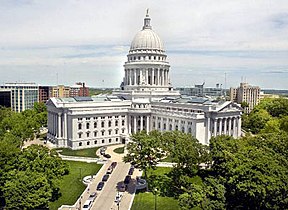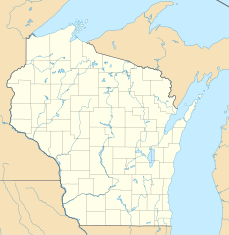Wisconsin State Capitol
| Wisconsin State Capitol | ||
|---|---|---|
| National Register of Historic Places | ||
| National Historic Landmark | ||
|
|
||
| location | 2 East Main Street, Madison , Wisconsin | |
| Coordinates | 43 ° 4 '28 " N , 89 ° 23' 5" W | |
| Built | 1906 | |
| architect | George B. Post | |
| Architectural style | Beaux Arts | |
| NRHP number | 70000031 | |
| Data | ||
| The NRHP added | October 15, 1970 | |
| Declared as an NHL | January 3, 2001 | |
The Wisconsin State Capitol is the seat of both chambers of government of the state of Wisconsin as well as the Supreme Court and the Governor. It is already the fifth state capitol of the state of Wisconsin or its predecessor. The Wisconsin State Capitol stands in the center of the city of Madison and eight streets run concentrically towards the 85 m high dome. According to a decree of 1989, no building may be within a mile higher in order not to impair visibility.
Previous buildings
With the establishment of the Wisconsin Territory in 1836, a capital was needed and the new government needed a meeting place. Speculators and large landowners vied for the new capital to be built on their land. The choice fell on the village of Belmont , founded spontaneously by John Atchison , where four simple wooden houses were already waiting for the new sovereigns. Timber samples show that the houses were prefabricated outside the territory, presumably in Pittsburgh , Pennsylvania, and only assembled on site. Today the houses are part of the First Capitol Historic Site .
From the beginning, the remoteness and the lack of infrastructure in Belmont were criticized. You should have moved to an already existing city. Belmont's fame thus only fought for a short time and the struggle among the large landowners to provide the location for a new capital continued. In 1837 the government moved to Burlington , Iowa , which was not much bigger than Belmont. After the city was added to the newly established Iowa Territory in 1838 , the government of the Wisconsin Territory had to change its seat again.
In the future capital, Madison, which at the time largely only existed on paper, a small capitol was already under construction at the site of today's State Capitol. It soon became too small and was replaced by a larger new building with a dome between 1857 and 1869. This also had to be expanded soon and from 1903 a new building was considered again. A great fire in 1904 paved the way for this.
The current building
The current building is the third State Capitol at this location. In 1906 construction began according to plans by the architects George B. Post & Sons from New York.
A central building was built on the plan of a Greek cross with a dome at the intersection of the axes, as is common for most state capitols. Both inside and outside, 43 types of rock from different states and countries were used. The facade and the dome are made of granite from Bethel , Vermont , while marble was used in the rotunda under the dome . a. relocated from Italy and Greece as well as Norwegian labradorite . Due to financial bottlenecks, the construction work dragged on until 1917.
Figure program
The Wisconsin State Capitol has an extensive program of figures. The dome is crowned by a golden, 4.7 m high statue. It is the work of the eminent sculptor Daniel Chester French and is an allegory of the state of Wisconsin. It shows a woman in an antique robe. She stretches her right arm commandingly forward, which characterizes the motto of the state of Wisconsin ( Forward ). A badger , the state animal of Wisconsin, sits on her helmet . Both features can also be found in the Wisconsin seal . In her left hand she holds a golden ball with an eagle on it, which in turn has a "W" on its chest.
Post's original plans included four small domes at the base of the central dome. The domes were eventually replaced by four groups of figures. These are works by the Austrian sculptor Karl Bitter and represent faith, strength, knowledge as well as prosperity and abundance.
The triangular pediments on the fronts of each wing are adorned with figures relating to the tasks of the government. The law and agriculture also come from Bitter, virtue from the German-born sculptor Adolph Weinman and wisdom from Attilio Piccirilli.
Individual evidence
-
^ Wisconsin State Capitol . In: National Historic Landmark summary listing . National Park Service. Archived from the original on April 3, 2009. Retrieved June 30, 2008.
Listing of National Historic Landmarks by State: Wisconsin. National Park Service , accessed March 13, 2020. - ^ Wisconsin State Capitol on the National Register Information System. National Park Service , accessed March 13, 2020.
- ↑ 1989 Wisconsin Act 222 (PDF) State of Wisconsin. April 12, 1990. Retrieved October 3, 2006.
- ^ The Progressive Era . In: 2015-2016 Wisconsin Blue Book: Chapter 8 - History Statistics (Retrieved February 22, 2016).
- ^ Wisconsin Gov., Capitol Tour . Retrieved January 2, 2015.
- ^ National Historic Landmark Nomination. United States Department of the Interior, National Park Service, accessed February 22, 2016 .
- ^ Wisconsin Gov., Capitol Tour . Retrieved January 2, 2015.
literature
- James M. Dennis: Karl Bitter. Architectural sculptor. 1867-1915. University of Wisconsin Press, Madison WI et al. 1967.
- Einar Einarsson Kvaran: Architectural Sculpture in America. Unpublished manuscript.
- Sarah Bradford Landau: George B. Post, Architect. Picturesque Designer and Determined Realist. The Montacelli Press, New York NY 1998, ISBN 1-885254-92-X .
- Josef Vincent Lombardo: Attilio Piccirilli. Life of an American Sculptor. Pitman Publishing Corporation, New York NY et al. 1944.
- Anton Rajer, Christine Style: Public Sculpture in Wisconsin. An Atlas of Outdoor Monuments, Memorials and Masterpieces in the Badger State. SOS! Wisconsin - Save Outdoor Sculpture, Madison WI 1999, ISBN 0-9664180-2-6 .
- Ferdinand Schevill: Karl Bitter. A biography. The University of Chicago Press, Chicago IL 1917.
- Wisconsin State Capitol. Guide and History. 33rd edition. State of Wisconsin - Department of Administration - Division of Buildings and Grounds, Madison WI 1991.





